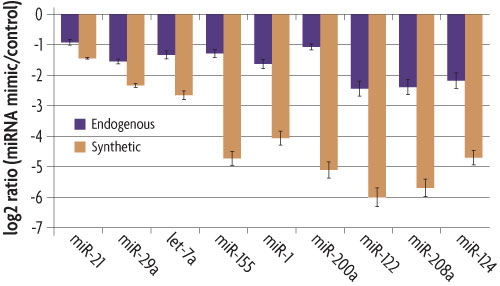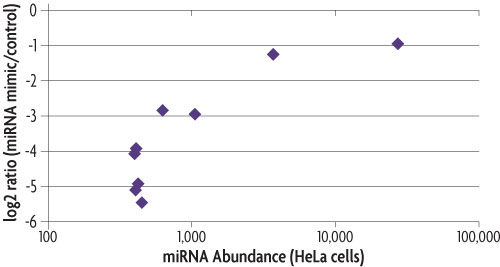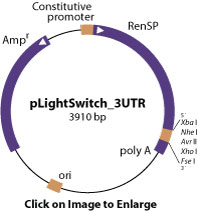The LightSwitch™ Synthetic miRNA Target Reporter Collection is ideal for performing miRNA target validation, as well as assessing the functional impact of of miRNA-3´UTR interactions. In contrast to the over 12K cloned endogenous 3´UTR constructs that make up the LightSwitch 3´UTR Reporter GoClone Collection, LightSwitch™ Synthetic miRNA Target Reporter constructs contain repeats of known 3´UTR sequences that have been optimized for increased miRNA binding. This enables them to provide stronger responses than the native, endogenous sequences. Thus, they are well suited for use as biosensors or positive controls in miRNA target validation experiments. They can also be used to help determine the levels of natural miRNA expression in your cell line and to screen for which cell lines will work best for your miRNA experiments (see Data tab). These transfection-ready miRNA biosensors together with the highly optimized assay reagents, transfection reagents, controls, miRNA Mimics and Inhibitors and detailed protocols allows you to perform your gene regulation reporter assay experiments immediately.
Find miRNA Target Reporters by clicking one of the groups below:
- miR-1...miR-99 | miR-100...miR-199 | miR-200...miR-299 |
- miR-300...miR-399 | miR-400...miR-499 | miR-500...miR-599 |
- miR-600...miR-699 | miR-700...miR-999 | miR-1000...miR-2300 |
- let-7 | CMV HIV1
Applications
- Validate miRNA Targets – Use as a positive control in miRNA target validation studies.
- Measure miRNA Levels – Use as a biosensor to measure relative levels of endogenous miRNA in your cell line.
- Pre-screen Cell Lines – Use to determine which cell lines will be most appropriate for experiments involving the specific miRNA mimics or inhibitors you wish to study.
Note: All LightSwitch constructs MUST be used with the LightSwitch Luciferase Assay Reagents to obtain optimal results with our novel RenSP luciferase. We also recommend that you include appropriate positive & negative control vectors when you perform your assays.
The LightSwitch Synthetic miRNA Target Reporter Collection includes over 900 constructs that contain optimized synthetic targets consisting of sequence repeats that are fully complementary to a variety of human and human viral miRNAs. The sequences are based on miRBase 16 annotations, and have been cloned into the pLightSwitch_3UTR reporter vector, which utilizes a constitutive promoter to drive expression of the novel, engineered RenSP luciferase gene. As the optimized target sequence has been cloned downstream of RenSP, the vector produces a hybrid RenSP luciferase-3´UTR transcript that is assayed using the LightSwitch Luciferase Assay Kit.
In addition to the LightSwitch Synthetic miRNA Target Reporter Collection, we offer over 12,000 endogenous human 3´UTR constructs as the LightSwitch 3´UTR Reporter GoClone Collection, which have also been cloned into the pLightSwitch_3UTR vector.
Both the LightSwitch Synthetic miRNA Target Reporter constructs and the LightSwitch 3´UTR Reporter constructs were designed to be co-transfected with our collections of LightSwitch miRNA Mimics and Inhibitors to study the effects of over-expression of a miRNA of interest, or to knock down the expression of endogenous human miRNAs in living cells.
Increased response of synthetic miRNA Target Reporters

Figure 1: Synthetic miRNA Target Reporters respond more strongly than endogenous 3´UTR target sequences.
The response of a synthetic element to the appropriate miRNA was measured in HT1080 or HeLa cells for a number of popular miRNAs. Briefly, 100 ng of an individual reporter construct was co-transfected in triplicate with either a microRNA mimic or a non-targeting miRNA control at a final concentration ranging from 20 nm - 50 nM. The average luminescence was calculated for mimic replicates and was then divided by the average for non-targeting control replicates. For a particular cell-line, a strongly-repressed human 3´UTR target is displayed alongside the repression observed for the synthetic target as the log2 ratio of mimic to non-targeting control signal.
Use of miRNA Target Reporters to determine miRNA levels in HeLa cells

Figure 2: Synthetic miRNA Target Reporters as biosensors for endogenous miRNAs.
The level of endogenous miRNA in the cell (x-axis) is inversely correlated with knockdown of the synthetic target reporter fusion in the presence of a miRNA mimic. Low knockdown suggests that the cell line expresses high levels of a miRNA, indicating that a miRNA inhibitor may be more effective in that cell line. Here, we compared the level of knockdown observed in HeLa cells for 9 synthetic miRNA target reporters previously tested for microRNA abundance in HeLa as detected by oligonucleotide microarrays (Barad et al. (2004) Genome Research 14:2486-2494). The Pearson’s correlation coefficient for these data was R=0.66.


